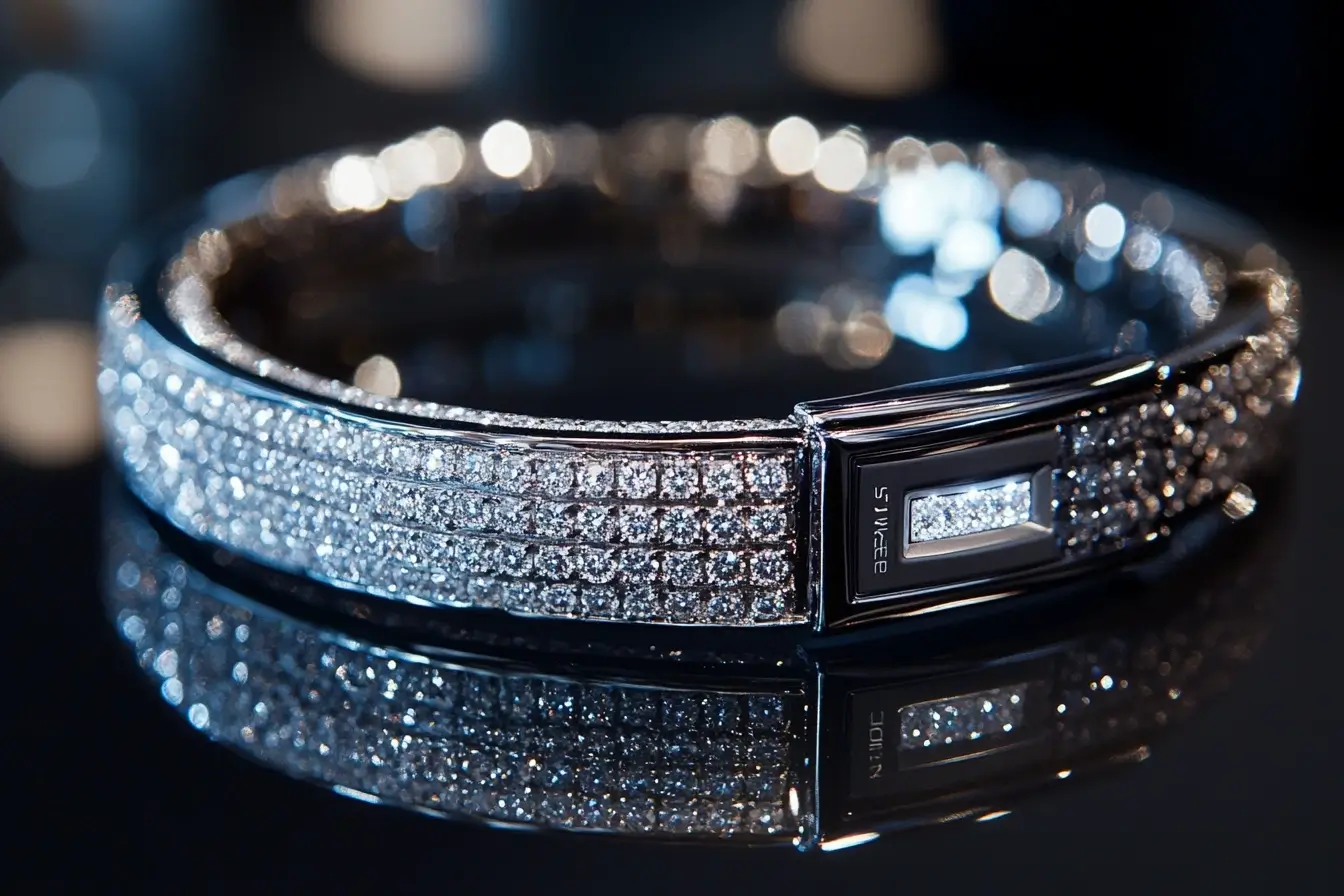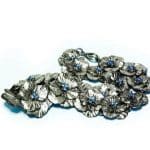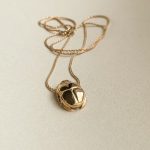The integration of NFC chips in high-end jewelry marks a fascinating intersection between cutting-edge technology and luxury craftsmanship. Near Field Communication (NFC) technology, known for its role in contactless payments and wireless data transfer, is beginning to revolutionize the jewelry industry. By embedding these tiny chips into exquisite pieces, designers are enhancing not only the allure of their creations but also enriching the consumer experience with interactive functionalities.
NFC technology allows for seamless communication between devices over short distances, typically a few centimeters. This capability opens up a myriad of possibilities in the realm of luxury jewelry, where exclusivity and personalization are paramount.
Jewelers can now offer their clients unprecedented features such as instant authentication, detailed information about the piece’s origin and craftmanship, and even customized messages that add sentimental value to each item. The adoption of NFC chips by high-end brands is transforming how consumers interact with their luxury purchases, making the ownership experience more dynamic and engaging.
As NFC technology becomes increasingly prevalent in luxury wearables, we’re witnessing an exciting marriage of tradition and innovation. Iconic jewelry houses renowned for their heritage craftsmanship are beginning to adopt modern techniques to enhance their offerings without compromising on elegance or artisanship.
These advancements not only secure valuable pieces against counterfeiting but also provide wearers with a sense of security and assurance about the authenticity of their investment. The proliferation of NFC chips within this domain hints at a trend where high-tech functionality will become an integral aspect of fine jewelry design, setting new standards for what it means to own a truly luxurious piece.
The Marriage of Tradition and Innovation
The integration of NFC chips in high-end jewelry exemplifies the harmonious blend of timeless craftsmanship and modern technology. At first glance, the age-old traditions associated with jewelry making might seem incongruous with cutting-edge digital advancements; however, the fusion of these elements spearheads a new frontier in luxury design.
Traditional jewelers, renowned for their exquisite attention to detail and artistry, now have innovative tools at their disposal. By embedding NFC chips into their creations, they are able to preserve the heritage and allure that define luxurious pieces while simultaneously embracing futuristic capabilities that enhance both function and form.
Luxury brands have been quick to recognize the potential of NFC technology in propelling their products into a visionary realm while still honoring traditions. For example, prominent designers such as Bvlgari and Cartier have integrated NFC chips seamlessly into their collections to offer more than just aesthetic value.
These illustrious names utilize this technology not only as a testament to modernity but also as an enhancement tool that enriches customer interaction with their masterpieces. As a result, consumers can now enjoy an unparalleled blend of tangible beauty and interactive technological features that were once unimaginable in traditional jewelry settings.
One compelling aspect of the marriage between tradition and innovation is how NFC technology provides additional layers of engagement for customers without compromising on classic elegance. Now, when purchasing high-end jewelry pieces embedded with NFC chips, clients receive not only an object of mesmerizing artistic merit but also access to exclusive content or services via simple contactless communication with their mobile devices.
Whether it’s personalizing a stunning locket with unique memory-laden messages or verifying authenticity instantly through historical data tracking, these interactions amplify the product’s worth beyond aesthetics alone, making the overall ownership experience richer for discerning buyers.
| Brands | Features |
|---|---|
| Bvlgari | NFC integration for enhanced interactivity |
| Cartier | Seamless blend of tradition and technology |
Enhancing Customer Experience
The integration of NFC chips in high-end jewelry has introduced a new dimension to the customer experience, transforming it into an interactive and engaging journey. By embedding NFC technology within exquisite pieces, luxury brands offer customers not only beautiful adornments but also a wealth of digital information and services right at their fingertips.
Imagine a client purchasing an exclusive necklace and being able to access detailed videos about its creation process simply by tapping their smartphone on the piece. This seamless interaction enhances consumer involvement, ensuring that each purchase becomes an educational and personalized experience.
One of the standout features enabled by NFC technology is product authentication. With counterfeiting being a major concern in the luxury market, NFC chips allow buyers to verify the authenticity of their pieces easily.
High-end jewelry equipped with these chips provides instant confirmation through a connected app or website, safeguarding both consumers and brands from fraudulent activities. Additionally, owners can access extensive documentation regarding their item’s history, designer details, and care instructions-offering transparency and confidence in every acquisition.
Moreover, these cutting-edge technologies pave the way for innovative virtual displays and augmented reality concepts within stores or at events. When potential buyers interact with jewelry containing NFC tech, they can visualize different styles or gemstone color variations without physically trying them on or altering the original piece.
For instance, if a customer is interested in seeing how a bracelet would look with sapphires instead of diamonds, the NFC chip can trigger an augmented reality feature that showcases this change on their device screen. By marrying tactile elegance with digital advancements, high-end jewelers are redefining what it means to offer exemplary service to discerning clientele.
- Product authentication ensures genuine purchases.
- Access to rich content such as creation videos.
- Augmented reality options for style variation display.
Security and Authentication Benefits
Unparalleled Security for Valuable Items
Incorporating NFC technology into high-end jewelry provides a groundbreaking level of security that is unprecedented in the luxury market. Traditionally, securing valuable jewelry has relied on physical safeguards and human scrutiny. However, with the integration of NFC chips in high-end jewelry, owners can enjoy an elevated sense of security through digital authentication methods.
These chips can be programmed to contain a unique identifier or encrypted data, making it virtually impossible for counterfeiters to replicate authentic pieces. As a result, buyers can trust the integrity and authenticity of their investment without requiring overly burdensome verification processes.
Tamper-Proof Features
One of the standout benefits of NFC chip technology is its tamper-proof capabilities. Once installed within the piece, any attempt to alter or remove an NFC chip can nullify its function or even send an alert to the owner or manufacturer.
This feature not only deters theft but also protects against unauthorized reselling and fraudulent practices in secondary markets. Because each NFC chip is linked directly to detailed provenance data stored securely, owners and potential buyers have access to vital background information on each piece’s origin, previous ownership history, and other relevant details that attest to its legitimacy.
Provenance Tracking: Ensuring Transparency
With provenance becoming increasingly important for consumers interested in luxury items, NFC technology offers significant benefits when it comes to tracking materials from their origins through production stages. High-end brands now have an opportunity to maintain detailed records accessible via a simple tap from an NFC-enabled device.
By utilizing this capability, brands are fostering transparency throughout their supply chains-providing insight into material sourcing as well as adherence to ethical production standards-thus ensuring peace of mind for conscientious consumers looking for sustainable options without compromising on style or elegance. This form of traceability not only enhances brand credibility but also aids consumer decision-making by offering verifiable claims regarding responsible luxury practices.
Personalization and Customization
Custom Experiences With NFC Technology
The integration of NFC chips in high-end jewelry opens a world of possibilities for personalization and customization, allowing jewelers to craft unique experiences tailored to individual customers. With this technology embedded in luxurious pieces, wearers can access custom data, such as personal messages or significant dates that hold sentimental value.
This adds a layer of intimacy to jewelry, transforming each piece from a mere accessory into a repository of cherished memories. Jewelers can work with clients to embed these personalized details within the NFC chip during the crafting process, thereby ensuring that buyers receive not just an item but an artifact imbued with personal significance.
A New Level of Luxury Interaction
Personalization extends beyond physical inscriptions or unique designs by introducing dynamic features that evolve over time. Owners can update their NFC-enabled jewelry with new information or messages as desired, fostering an ongoing relationship with their cherished items.
For instance, gifts like engagement rings or anniversary bands could contain evolving narratives about the couple’s journey together or milestone achievements experienced during their marriage. These updates can be done seamlessly through connected devices, allowing the jewelry to grow and change alongside its owner while maintaining its exclusivity and charm.
Customization in the Retail Experience
The retail experience is also significantly enhanced by the incorporation of NFC technology into high-end jewelry offerings. Stores can provide interactive customizations upon purchase.
A customer might choose engraved initials supplemented by digital content linked via the embedded chip; at special events or launches, brands could offer limited-edition digital features accessible through these chips, further enriching consumer engagement with exclusivity-driven offers. Brands are leveraging this technological advancement to develop strong emotional connections between consumers and their products, positioning themselves at the forefront of luxury innovation while emphasizing personalization in every aspect of acquisition and ownership.
Impact on Sustainability and Ethical Practices
The integration of NFC chips in high-end jewelry presents a unique opportunity to advance sustainability and ethical practices within the industry. Traditionally, tracing the origins and authenticity of luxury materials has been challenging, but NFC technology offers a solution by providing a transparent digital history of each piece.
With embedded NFC chips, jewelers can track the sourcing of gems and metals, ensuring they adhere to ethical standards such as conflict-free certifications or sustainability benchmarks. This development is pivotal not only for maintaining brand integrity but also for meeting the growing consumer demand for responsibly sourced products.
By embedding NFC technology, high-end jewelry brands can facilitate educated purchasing decisions through instant access to detailed information via smartphones or other devices. Consumers who tap their NFC-enabled jewelry piece can receive comprehensive data about its origins and craftsmanship process.
This includes insights into material recyclability and how the piece supports community-based mining initiatives. When faced with an ever-increasing awareness around environmental issues, this capability becomes a competitive advantage in capturing eco-conscious markets that value transparency.
Additionally, employing NFC chips promotes sustainable practices through better inventory management and reduced waste in production processes. Real-time data collection from these chips allows brands to refine logistics, reduce overproduction, and minimize carbon footprints associated with unnecessary shipping or storage.
On top of elevating production efficiency, these sustainability practices are echoed within marketing narratives across branding platforms where businesses articulate their commitment to responsible consumption trends publicly. These efforts underscore how digitization via NFC can align high-end jewelry brands with global sustainability goals like those advocated by various environmental think-tanks.
| Aspect | Details |
|---|---|
| Sustainability Enhancement | NFC provides traceable sourcing information |
| Consumer Education | Access detailed material origin data |
| Production Efficiency | Improved inventory management using real-time data |
Challenges and Considerations
The integration of NFC chips in high-end jewelry presents both exciting opportunities and complex challenges. As this technology becomes more entrenched within the luxury market, it is essential to consider the potential technical issues that may arise.
One significant challenge is ensuring the reliability and durability of NFC chips integrated into delicate jewelry pieces. The intricate craftsmanship of fine jewelry often involves unique materials like gold, platinum, or precious gemstones, which can pose challenges for incorporating electronic components without compromising the aesthetics or structural integrity.
Privacy and data security are paramount concerns as well when discussing wearable technology embedded in personal items. Consumers expect that their interactions with NFC-enabled jewelry will be private and secure, given the intimate nature of such accessories.
The possibility of unauthorized data access or transmission raises ethical questions about consumer protection and information privacy. Luxury brands must therefore implement robust encryption methods and provide assurances regarding how data collected via these RFID tags is stored, used, and protected from breaches.
Furthermore, the environmental impact associated with electronic waste poses a considerable concern as more tech features are incorporated into product designs traditionally known for their sustainability. The production and disposal of NFC chips add additional layers to discussions around eco-friendly practices within the jewelry industry.
Balancing technological advances with sustainable principles requires thoughtful design choices and responsible sourcing at every stage-from manufacturing processes to end-of-life disposal solutions for these advanced materials-all while maintaining transparency with consumers about these practices to build trust in this burgeoning aspect of luxury goods innovation.
The Future of Jewelry With NFC Technology
As we peer into the future of jewelry enhanced by NFC technology, one can envision a paradigm shift in consumer expectations and industry standards. The integration of NFC chips in high-end jewelry not only sets a new benchmark for interaction but also unlocks possibilities previously unimagined.
By embedding these tiny yet powerful elements within luxurious pieces, brands can offer customers personalized narratives tied to each item, such as an emotional message from a loved one or a digital memory filled with significance. This seamless blend of technology and artistry paves the way for pieces that are not simply worn but experienced on a whole new level.
Looking forward, this melding of advanced tech and sophisticated design will likely spur innovations in customer experience and engagement strategies. In a world where consumers increasingly demand bespoke experiences tailored to their individual preferences, NFC chips afford luxury brands an edge through hyper-personalization; they enable buyers to access exclusive content, previews of future collections, or invitations to private events with just a tap.
With each piece potentially serving as a portal to an exclusive club or community, owning high-end jewelry transcends traditional notions of luxury to encompass personal identity and social belonging.
Furthermore, as these technologies continue to evolve, so too might the infrastructure surrounding them. For instance, stores may become more digitally interactive environments that leverage NFC-enabled devices to provide educational insights or immersive storytelling about gemstones’ origins directly from the showcase floor.
As sustainable practices increasingly dominate consumer consciousness, NFC technology might aid brands in openly conveying their eco-credentials by demonstrating transparent sourcing practices and fair trade certifications via real-time data delivered alongside physical products. Ultimately, the integration of NFC chips in high-end jewelry represents not merely enhancement but transformation-pushing both boundaries and imaginations toward truly exciting horizons in luxury fashion’s future landscape.
Case Studies
One notable example of the integration of NFC chips in high-end jewelry is the collaboration between Italian luxury house Bulgari and tech firm WISeKey. In this case, Bulgari incorporated NFC technology into its jewelry collections to enhance both security and consumer engagement.
The implementation allows customers to access detailed product information directly from their smartphones by simply tapping their device against the piece. This capability not only provides authentication and provenance details, ensuring that buyers can verify the authenticity of their purchase, but also enhances the storytelling aspect by offering insights into each piece’s unique craftsmanship history.
Similarly, French luxury brand Cartier has ventured into the realm where technology meets tradition through its use of NFC chips. By embedding these chips into select pieces, Cartier offers clients exclusive content such as an artist’s video message or a personalized digital certificate of authenticity.
This bridged approach intertwines innovation with tradition, thereby cultivating deeper emotional connections between consumers and their cherished acquisitions. Through this initiative, Cartier addresses growing consumer expectations for transparency while elevating the overall purchasing experience by making it more personal and interactive.
Moreover, Swiss brand de Grisogono exemplifies another successful adaptation of this cutting-edge technology within its iconic jewelry collection. The brand employs NFC chips not only for identity verification but also to provide insight into sourcing practices and ethical standards adhered to during production.
Consumers who invest in de Grisogono’s pieces receive assurance regarding both quality and sustainability-a vital consideration for today’s conscientious luxury consumer. These advancements display how luxury brands are embracing technological innovations like NFC to not only retain relevance in a fast-evolving market but also lead industry efforts towards greater transparency and sustainable practices.
Conclusion
The integration of NFC chips in high-end jewelry represents a pivotal shift that elegantly bridges the past and future of luxury goods. As we have explored, this technology not only enhances the customer experience by providing interactive features such as authentication and product history but also strengthens security measures with tamper-proof and provenance tracking capabilities.
These advancements ensure that while the timeless beauty and craftsmanship of traditional jewelry are retained, they are augmented with modern functionalities that meet today’s consumers’ expectations for connectivity and personalization.
Moreover, NFC technology opens new avenues for personalization, allowing owners to embed customized messages or unique data within their jewelry pieces. This added layer of personalization transforms each piece into not just an accessory but a deeply personalized keepsake, broadening emotional connections.
The ability to verify authenticity instantly adds further value to each piece, reassuring clients about their investments’ legitimacy and origins. Additionally, in an era where sustainability is paramount, NFC chips pave the way for more transparent material sourcing and production processes within the industry.
Despite some challenges related to privacy concerns, environmental impact, and ethical implications associated with electronics in fine jewelry, the benefits significantly surpass these hurdles. With thoughtful implementation strategies adopted by luxury brands leading this transformation, consumer trust can be maintained while setting new standards for innovation in high-end jewelry design.
Ultimately, by embracing NFC technology, jewelers can enhance their offerings while preserving traditions dating back centuries-truly creating a stunning amalgam of historical richness with cutting-edge advancement that sets exciting precedents for the future of luxury goods.
Frequently Asked Questions
What Is NFC Integration?
NFC integration refers to incorporating Near Field Communication technology into devices or systems, enabling them to communicate wirelessly with other NFC-enabled devices within close proximity. This is achieved by embedding an NFC chip that facilitates quick data exchange when two devices are brought near each other.
Frequently found in smartphones, smartwatches, and payment terminals, this technology simplifies tasks like contactless payments, secure access control, and information sharing between compatible devices. By eliminating the need for physical connections or complex manual pairing procedures, NFC integration enhances user convenience and streamlines various personal and commercial applications.
What Does NFC Mean on Jewelry?
When applied to jewelry, NFC means that the piece contains a small embedded chip enabling it to connect wirelessly with other nearby NFC-enabled devices. This integration transforms traditional accessories into multifunctional gadgets allowing users to perform actions such as sharing digital information or accessing mobile apps just by bringing their jewelry close to a compatible device.
For instance, an NFC-enabled ring could be used for contactless payments or storing digital identification data securely while maintaining its aesthetic appeal as a piece of jewelry. This combination of fashion and technology illustrates how practical functionalities can be elegantly fused with everyday wearable items.

Welcome to my jewelry blog! My name is Sarah and I am the owner of this blog.
I love making jewelry and sharing my creations with others.
So whether you’re someone who loves wearing jewelry yourself or simply enjoys learning about it, be sure to check out my blog for insightful posts on everything related to this exciting topic!



